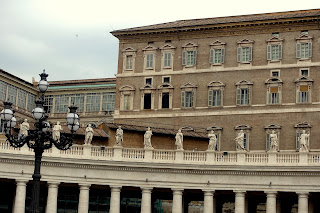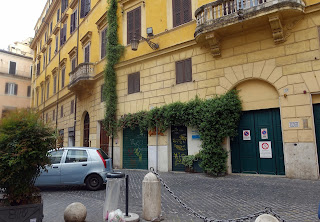 |
| A commemorative card of the Lateran Accords, with the ineffectual King Vittorio Emanuele III at left (his Savoy house symbol above), Mussolini center, note, with his fasce symbol above, and Pope Pius XI right, with the papal symbol - papal hat and crossed keys, above right. |
Where was the Catholic Church during Mussolini's rise to power? Did it play a role in the increasing totalitarianism of the regime, the persecution of the Jews in Italy, or the invasions of other countries that marked the Fascist regime? Those are difficult questions, and they fit with the near total confusion most of us have about Italy's role in World War II.
The Pope and Mussolini, David Kertzer's latest book, goes a long way towards providing some answers.
Kertzer is one of the best historians of the relationship between the Catholic Church and the secular side of Italy. Along with his knowledge of the 19th and 20th centuries in Italy, he brings to this book knowledge of the vast Church archives that were opened only within the past 10 years, as well as the detailed records of the Fascist police, who had spies in the Vatican recording every move. Thus Kertzer, as his subtitle asserts, can tell us "The Secret History of Pius XI and the Rise of Fascism in Europe."
Most of this story takes place in Rome, the seat of both the Pope's and Mussolini's power. It starts with the Pope locked in the Vatican,
where the Popes had been in self-imposed exile since the secular forces took over the city, and formed the state, in 1870. As Kertzer describes it, "Although the Church no longer ran the city, Rome still seemed to have a church on every block."
 |
The Papal rooms in the Vatican where Mussolini's
negotiators met with Pope Pius XI's representatives. |
The two men - Pope Pius XI and Mussolini - came to power in 1922, the year Pius XI was elected Pope and Mussolini orchestrated the Fascist March on Rome. They shared important values, according to Kertzer. "Neither had any sympathy for parliamentary democracy. Neither believed in freedom of speech or freedom of association. Both saw Communism as a grave threat. Both thought Italy was mired in crisis and that the current political system was beyond salvation." (One might think of Donald Trump in a similar vein.)
 |
The Chigi Palace, seat of Mussolini's government. One of
Mussolini's "gifts" to the Pope, to try to make him more
manageable, was the Chigi library. The Pope started life
as a librarian. |
Mussolini was not instantly easy to appreciate, and his movement was violent. To gain approval, Kertzer argues, the Fascists needed the Vatican to play a major role in legitimizing the new regime. Mussolini had at one time been a "
mangiaprete" or priest-eater, and his wife, Rachele (as distinguished from his various mistresses, including the Jewish intellectual Margherita Sarfatti), remained staunchly anti-clerical.
Kertzer discovered from his work in the archives not how the Pope and Mussolini were different, but all they had in common Besides their common values, listed above: "Both had explosive tempers. Each bristled at the charge of being the patsy of the other. Both demanded unquestioned obedience from their subordinates...Each came to be disillusioned by the other, yet dreaded what would happen if their alliance were to end."
 |
Piazza della Pigna in central Rome, where Mussolini met with
Cardinal Pietro Gaspari as part of the negotiations that led to the
Lateran Accords. Mussolini entered the home of Count
Carlo Santucci from this piazza. The Cardinal entered from the
other side. The home had the advantage of entrances on two
different piazzas - so the meeting could be kept secret. |
The mutually supportive relationship between the two men led to
the Lateran Accords of 1929, signed on February 9. The Accords gave the Vatican specific territories in Rome (but not the Pamphili gardens it also wanted); Catholicism as the state religion - allowing crucifixes back in school classrooms; recognition of religious marriages for the first time since 1870; and a lot of money.
In return, the Pope supported Fascism. One must recall at this time, many in the US did as well. Cardinal Spellman wrote, "These are wonderful days to be alive and still more wonderful to be alive in Rome," adding that the Pope and Mussolini would find their places in history. And President Franklin D. Roosevelt initially was positively inclined towards Mussolini.
As the Accords were being negotiated, the Pope saw Mussolini as the "man sent by providence," one who basically was releasing the Church from its exclusion from Italian life.
From February 9, 1929 onward the Pope and Mussolini continued an awkward dance, as the Pope continually tried to have the Lateran Accords firmly enforced - especially with respect to maintaining the Catholic Action social groups - and Mussolini tried to move away from them. My conclusion, after reading Kertzer's book, is that Mussolini outfoxed the Pope. By threatening to take away aspects of Catholicism's power in the state institutions, the Duce led the Pope to prop him up after opposition leader Giacomo Matteotti was killed by Fascist thugs (1924) [and Mussolini thought, because of the reaction to that murder, that his regime was doomed]; successfully kept the Pope silent when
Italy invaded Ethiopia (1935); and managed to convince the Pope to keep his mouth shut when the racial laws (1938) went into effect.
 |
The lodgings for the Jesuits, next to the Church of the Gesu' in
central Rome. The head of the Jesuits, the Polish Wlodimir
Ledochowski, was among the most fanatical anti-Semites
advising Pope Pius XI. Ledochowski, according to Kertzer,
thwarted some of Pius XI's attempts to counter the Fascist
racial laws. |
It's clear, according to Kertzer, that this Pope was uncomfortable with all of these actions by Italy and Mussolini. At the same time, he could not imagine the Church having as great a role in the Italian state as it had with Mussolini in power. Pius XI even allowed the Catholic political party, the Popular Party, to be disbanded; its founder, the Sicilian priest Don Luigi Sturzo, was sent into exile in London for more than 20 years.
Pius XI was especially troubled with the racial laws, in part because he did not believe in biologically separate races, but perhaps most because he wanted Jews who had converted to Catholicism not to be treated as Jews. Yet the Pope was surrounded by others in the Vatican who were more conservative than he, and some of whom were virulently anti-Semitic (see the reference to the Jesuit leader in the photo caption at right). Pius XI came to despise Hitler. He closed the Vatican museums and left Rome when Hitler made his famous 1938 visit to Rome.
"The Vatican," Kertzer demonstrates, "made a secret deal with Mussolini to refrain from any criticism of Italy's infamous anti-Semitic 'racial laws' in exchange for better treatment of Catholic organizations. This fact is largely unknown in Italy, and despite all the evidence presented in this book, I have no doubt many will deny it."
After more than 15 years of the
pas de deux with Mussolini, the Pope was ready to be somewhat more outspoken, going so far as to prepare a speech that was seen at the time as highly critical of Fascism.
But Mussolini not only outfoxed the Pope, he also outlived him. Pius XI died February 10, 1939, and the very pro-German Eugenio Pacelli, taking the name Pius XII, succeeded him. That speech Pius XI haf prepared was never given, and even its full text - hardly the heavy criticism some thought at the time - was repressed until recently.
 |
| Photos were not permitted, but this painting illustrates the visit. Mussolini went to the Vatican only once, and hated going there. His pact with Pius XI was purely practical. He appeared to remain a "mangiaprete," or "priest-eater." |
Two very good reviews of Kertzer's book when it first appeared in 2014 are by
Alexander Stile in
The New York Review of Books (interestingly titled, "The Pope Who Tried"), and
Steve Donoghue in
The National.
Dianne











